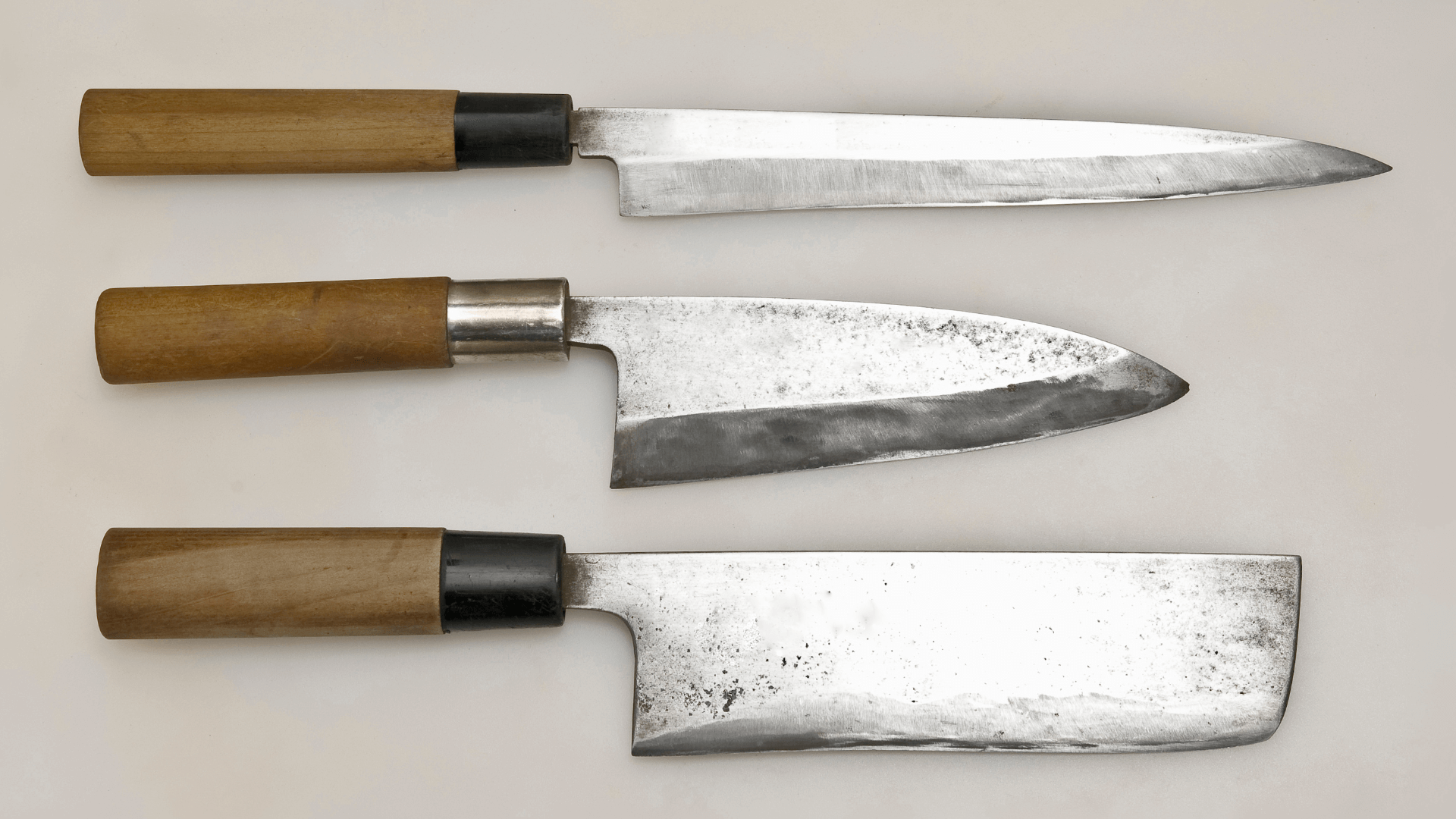I’m willing to bet that almost everyone reading this article is dissatisfied with their kitchen knives, and if you aren’t, you probably should be. This sad reality has two likely causes. Firstly, many people seem to believe that knives are multipurpose, and that one or two can achieve all the necessary cutting tasks in a kitchen. If this is you, I’m here to tell you that this is unfortunately not true. Secondly, I’m sure that most of you are using tragically blunt knives.
While I find the state of most people’s knives a bit heart-breaking, it’s also understandable. The price tags and vast range of knives on the market can be a little daunting, not to mention the world of sharpening. But I’m here to help!
I’ve assembled a list of what I believe are the five essential knives, as well as the nice-to-have ones for enthusiasts and professional chefs, and how to care for them.
1. The chef’s or cook’s knife
A chef’s knife is as close as it gets to a multipurpose knife, and it’s the one you’ll be using most. The blade is about 16 cm and 30 cm long and tapers to a sharp point.
The shape allows a rocking motion that is optimal for chopping most ingredients – a technique that is well worth mastering for your long-term cooking enjoyment.
I prefer a slightly smaller chef’s knife, as I find it more agile and a bit gentler on the wrist.
Another suggestion in this category is a Santoku knife, which is the Japanese version of the Western chef’s knife. This has a more rounded tip and a slightly shorter blade. It’s slightly less tough than a chef’s knife but better for precision cutting. Whichever way you go, it is worth investing in a high-quality brand such as Wüsthof, as this knife will be with you your whole cooking life.
2. The serrated paring knife
Sometimes called a tomato knife, the serration cuts through most ingredients with satisfying ease. I highly recommend the Victorinox 11cm round-nosed variety. It’s very well-priced, highly effective and widely available.
This workhorse of a knife is the one most frequently grabbed for quick tasks, especially when your chef’s knife is a bit dull.
I prefer a slightly smaller chef’s knife, as I find it more agile and a bit gentler on the wrist.
They can also double as steak knives if you buy a bunch. These aren’t forever knives, as they do become blunt over time and can’t really be sharpened, but they are so cheap that this isn’t the end of the world.
3. The straight paring knife
A short, pointed paring knife is great for small finicky jobs such as peeling garlic, trimming veggies, and cutting open packaging. Again, Victorinox is a good option, though my personal favourite is the Shun 10cm paring knife. It’s a real beauty and has the added bonus of being easy to sharpen, which isn’t the case with many of the cheaper and slightly smaller paring knives.
4. The bread knife
For me, a good bread knife is kind of life-changing, especially since the sourdough renaissance. With its thick, tough crust and contrastingly soft and sticky interior, the sourdough loaf is the real test of a bread knife, and the bane of many.
Those that have passed the test for me are the Wüsthof Double-Serrated Bread Knife, the Mercer Serrated Slicer, and the Victorinox Pastry Knife. Bread knives are not easy (impossible?) to sharpen, so choosing one made from high-quality steel is really important.
5. Scissors
While not a knife, scissors are an essential member of the cutting club. Having good scissors on hand prevents you from using your knife to cut things you know you shouldn’t. I’m not necessarily a proponent of kitchen shears as I find, that while sturdy, they are often not very sharp.
I find that a solid pair of everyday scissors works well. In Korean cooking, scissors are widely used to finely chop spring onions, chives, tteokbokki and a whole range of other ingredients. I’ve applied this to many other cuisines, and find that my scissors are extremely well used these days.
Other sharp implements worth investing in are a Y-shaped peeler (Austware is my favourite), a Microplane grater (the Classic Zester is still the best in my opinion, and is the superior garlic crusher), and a mandolin slicer, probably my most valued kitchen tool (so far, the only brand worth writing about is Benriner).
Non-essential, but nice to have
Once you’ve stocked up on all of the above, depending on how much you like knives and how much you like to cook, you may find yourself wanting a few extras.
Next up, I’d go for a good-quality carving or slicing knife. A sashimi knife is essential for me, and can also be used to slice meat, as long as there are no bones to damage its perfect edge. Try the Wasabi Black 23cm carving knife, or the Global G60 Ham/Salmon/Roast slicer.
A cleaver is a fun tool for heavy-duty jobs, such as portioning meat with bones, and even finely chopping parsley in bulk. I also have a fondness for a curved paring knife, which is somewhat old-fashioned but surprisingly useful for finicky jobs.
I love my Japanese Deba, or fish filleting knife. It’s completely different to a Western fish filleting knife but, in my opinion, more effective. Either way, a fish filleting knife is good to have, as is a boning knife. For knife nerds, there’s a whole world of Japanese speciality knives to discover. The Kitchen Samurai online store is an excellent starting point.
Looking after your knives
Firstly, make sure you’re using the right cutting board. I like wood, but a thick plastic board is also perfect. No glass or marble ever, and please never on the kitchen counter! I would also strongly advise against using thin cutting mats unless they are placed on top of a plastic or wooden board.
Make sure you’re using the right cutting board. No glass. No marble. And definitely not the counter.
Knives should always be washed by hand and dried immediately to avoid rust. No dishwasher ever! The high heat and aggressive detergents are a recipe for bluntness and rust. The best way to store a knife is on a wall-mounted knife magnet. The second best is a knife block, and the least advised is rolling around loose in a knife drawer.
However damaged your knives are, they are almost never beyond saving. Most often, all they need is a good sharpening. For mild wear and regular use, I recommend the Wüsthof diamond steel. It’s streets ahead of other (admittedly cheaper) steels, and instantly improves even very dull knives. I would avoid the rolling bar-style knife sharpeners, as they tend to wear down the angle of the blade in the long term.
The best way to sharpen knives is with a ceramic whetstone but, unless you are proficient in this, my suggestion would be a regular (perhaps annual) knife sharpening service. Kitchen Samurai is my go-to, but there are many other options. Ask around at high-end restaurants in your area, chances are they will have a local recommendation.
You’ll be amazed by the simple pleasure using the correct knife, freshly sharpened, will bring to your cooking experience.
In this article, we recommend some products that we believe you might like. We’re not affiliated with any of the brands or products mentioned, and we don’t make any money if you click the links and buy something. Our recommendations are based on our own research and are solely intended to help you find the products we mention.



How much the set
Hi Flip, we’ve included links to a couple of local retailers throughout the article who stock these products in SA. Just hit the links and you’ll see all the prices on their websites.
I like the stel
Lovely article.
Caitlin knows her stuff.
She sure does! Thanks, Derek.